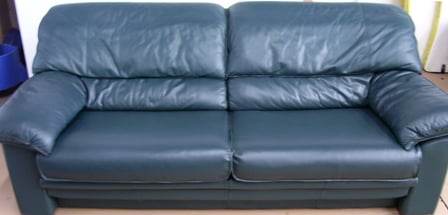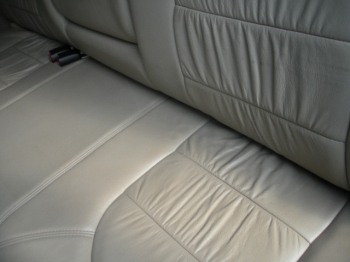What is Fully-Finished Leather?
At its core, fully finished leather refers to leather that has undergone extensive surface treatment during the tanning process to enhance its durability, appearance, and functionality. This includes the application of protective layers, pigmentation, and a final top coat to ensure a uniform finish.
These treatments preserve the leather’s natural beauty while boosting its stain resistance, making it an excellent choice for everyday use.
Fully finished leather is renowned for striking the perfect balance between natural aesthetics and practicality. Whether it’s a sleek sectional sofa, a durable handbag, or a finely crafted pair of shoes, this type of leather is the cornerstone of many high-quality leather products.

Understanding leather basics
Leather, in its simplest form, is the result of transforming animal hides into a durable and versatile material through a process called tanning.
This ancient craft not only preserves the hide but also enhances its strength, flexibility, and resistance to decay. However, not all leather is created equal. The quality, texture, and finish of leather depend on the specific grade and treatment it receives.
Grades of Leather
Understanding the different grades of leather is essential when evaluating quality:
- Full Grain Leather
- This is the highest quality leather, made from the top layer of the hide.
- It retains the natural grain and imperfections, showcasing the hide’s natural beauty.
- Over time, it develops a rich patina, adding character and enhancing its appeal.
- Top Grain Leather
- Slightly below full grain in quality, it undergoes sanding to remove imperfections.
- While it loses the natural grain, it offers a smoother surface and is often more stain-resistant.
- Genuine Leather
- A term often misinterpreted as high quality, genuine leather refers to a lower grade made by bonding leather layers.
- Though durable, it lacks the longevity and aesthetic appeal of higher grades.
- Bonded Leather
- Created from leather scraps fused with adhesives, bonded leather is a budget-friendly option.
- However, it is less durable and not suitable for long-term use.
- Corrected Grain Leather
- This type of leather has undergone sanding and embossing to mask blemishes.
- It provides a consistent, polished appearance but sacrifices the authentic look of natural grain.
Each grade of leather has its unique properties, making them suitable for different applications. Fully finished leather often incorporates top grain or corrected grain leather to achieve its signature uniformity and durability.
Characteristics of fully finished leather
Fully finished leather is highly valued for its durability, versatility, and elegant appearance. This type of leather undergoes additional treatment during the tanning process to improve its functionality while maintaining its visual appeal.
1. Leather Surface Treatment
- Fully finished leather receives a series of treatments designed to enhance its surface.
- A pigmented layer is applied to provide uniform color and mask any natural imperfections in the hide.
- This treatment ensures the leather is not only visually appealing but also resistant to wear and tear.
2. Top Coat and Protective Layer
- A final top coat is applied as part of the finishing process. This clear or pigmented layer acts as a shield against stains, scratches, and moisture.
- The protective layer improves the leather’s stain resistance, making it ideal for upholstery and leather furniture that faces daily use.
- This coating also makes fully finished leather easier to clean and maintain compared to untreated varieties.
3. Natural vs. Embossed Grain
- Fully finished leather can retain its natural grain, showcasing the hide’s authentic beauty and texture. However, it often undergoes embossing to create uniform patterns or textures.
- Embossed leather is commonly used to replicate exotic looks (like crocodile or snakeskin) or create consistent textures for furniture and other goods.
- The embossing process helps hide blemishes or imperfections while offering a polished, high-end appearance.
4. Durability and Longevity
- The finishing process increases the leather’s lifespan, making it resistant to environmental factors like sunlight, humidity, and regular wear.
- Fully finished leather is less prone to fading and cracking, making it a practical choice for both fashion and functional items.
- Its uniform surface also reduces the visibility of minor scratches or scuffs, keeping it looking new for longer.
Fully finished leather strikes a balance between natural aesthetics and practicality. Whether it retains its authentic grain or features an embossed design, this leather’s polished appearance and protective qualities make it a favorite for high-end leather products.
Types of leather finishes
The finishing process is a crucial step in determining the look, feel, and performance of leather. Fully finished leather is one of several types of finishes applied to leather, each offering unique characteristics tailored to specific uses. Understanding these finishes helps distinguish the qualities of fully finished leather from other varieties.
1. Aniline Leather
- Features: Aniline leather is the most natural form of leather, with no pigmented or protective layers applied. It retains the hide’s natural grain and blemishes, showcasing its raw beauty.
- Advantages:
- Luxurious, soft texture.
- Develops a patina over time, adding charm and character.
- Drawbacks:
- Prone to stains and fading due to the lack of a protective layer.
- Requires more maintenance and care.
2. Semi-Aniline Leather
- Features: Semi-aniline leather combines the natural beauty of aniline leather with added durability. A light pigmented coating is applied, offering minimal protection while retaining most of the leather’s natural appearance.
- Advantages:
- Better stain resistance than aniline leather.
- Retains much of the hide’s natural grain.
- Ideal for high-quality upholstery and leather goods.
- Drawbacks:
- Slightly less natural-looking than pure aniline leather.
- Limited resistance to heavy wear and tear compared to fully finished leather.
3. Pigmented Leather
- Features: Pigmented leather is fully finished leather with a protective top coat and color pigments. This finish creates a consistent and durable surface that’s easy to maintain.
- Advantages:
- Excellent durability and stain resistance.
- Uniform appearance, hiding blemishes and imperfections.
- Popular in furniture, car upholstery, and leather goods.
- Drawbacks:
- Less natural in appearance due to the pigmented coating.
- May feel less soft compared to untreated leather.
4. Faux Leather
- Features: Faux leather is a synthetic alternative designed to mimic the look of real leather. While it is not derived from animal hide, its finish can resemble natural leather closely.
- Advantages:
- Affordable and vegan-friendly.
- Resistant to water and stains.
- Available in a wide range of colors and patterns.
- Drawbacks:
- Lacks the durability, texture, and aging characteristics of real leather.
- Shorter lifespan compared to genuine leather.
5. Corrected Grain Leather
- Features: Corrected grain leather undergoes sanding and is often embossed to create a uniform surface. It is typically used for fully finished leather products that require a flawless appearance.
- Advantages:
- Polished, consistent surface.
- Durable and easy to maintain.
- Drawbacks:
- Loses much of the hide’s natural grain and texture.
By combining different finishes with various grades of leather, manufacturers can create products that meet specific needs for durability, aesthetics, and functionality.
Benefits of Fully Finished Leather
Fully finished leather offers a unique combination of beauty, durability, and practicality, making it a top choice for a wide range of applications. Its enhanced characteristics provide advantages that appeal to both manufacturers and consumers alike.
1. Ideal for Upholstery and Furniture
- Stain Resistance: The pigmented and protective top layers make fully finished leather resistant to stains, spills, and moisture. This makes it a preferred choice for leather furniture and sectionals, especially in households with children or pets.
- Durability: Fully finished leather can withstand everyday wear and tear, making it suitable for heavily used furniture like sofas and chairs.
- Aesthetic Appeal: Its uniform surface ensures a consistent and polished look, elevating the elegance of upholstery in both modern and classic interiors.
- Ease of Maintenance: The protective coating makes cleaning and upkeep simple, requiring minimal effort to maintain its pristine appearance.
2. Perfect for Leather Goods
- Versatility: Fully finished leather is used in a variety of leather products, from handbags and wallets to belts and shoes. Its adaptability ensures it meets the demands of different markets.
- High-Quality Appearance: The pigmented surface hides natural blemishes, resulting in a smooth, flawless finish that enhances the product’s overall look.
- Longevity: Fully finished leather products are designed to last for years, thanks to their protective layers that resist fading, cracking, and wear.
3. Practicality and Protection
- Protective Layers: The added top coat shields the leather from environmental damage such as UV rays, moisture, and dirt.
- Cost-Effectiveness: While fully finished leather is an investment, its extended lifespan and low maintenance requirements make it a cost-effective choice over time.
Fully finished leather is a versatile material that balances style and durability, making it ideal for high-quality leather goods, elegant furniture, and everyday accessories. Its benefits go beyond aesthetics, offering practicality and reliability in nearly every application.
Fibrenew fully finishes every leather restoration job
Get in touch with your local Fibrenew professional for all your leather, plastic, and vinyl repair needs.
Want to run a business that gives you incredible earning potential and the flexibility to take control of your time and life? Join the Fibrenew Family!
Check out our free Franchise Information Report for everything you need to know. And check out the always-updated list of Fibrenew Certified Resales.
Also, enjoy these valuable resources on all things leather, plastic, and vinyl repair, franchising, sustainability, and more:
What is fully finished leather? Fully finished leather is leather that has undergone extensive surface treatment during the tanning process. This includes the application of protective layers, pigmentation, and a top coat to enhance durability, stain resistance, and aesthetic uniformity. How is fully finished leather different from full grain leather? Fully finished leather often involves treatments like pigmentation and embossing for a consistent appearance, while full grain leather retains its natural grain and imperfections. Full grain leather is untreated and develops a patina over time, whereas fully finished leather prioritizes durability and a polished look. Is fully finished leather durable? Yes, fully finished leather is highly durable. The protective top coat and pigmented surface make it resistant to stains, scratches, and fading, making it ideal for furniture, upholstery, and high-use leather goods. Does fully finished leather look natural? While it can retain some of the hide’s natural beauty, fully finished leather is often treated to create a more uniform appearance. Embossing and pigmentation may reduce the visible natural grain but enhance the leather’s visual consistency. What are common uses for fully finished leather? Fully finished leather is commonly used in furniture (e.g., sofas, sectionals), car upholstery, handbags, shoes, belts, and other leather goods that require durability, ease of maintenance, and a polished appearance. How do I care for fully finished leather? Care is simple: regularly clean with a soft cloth, use a mild leather cleaner for spills, and condition it periodically with a high-quality leather conditioner to maintain its softness and prevent cracking. Is fully finished leather better than other types of leather? The answer depends on the application. Fully finished leather is superior for durability, stain resistance, and low maintenance, making it ideal for everyday use. However, those seeking the natural look and aging characteristics of leather may prefer untreated full grain leather.FAQ: Fully finished leather



